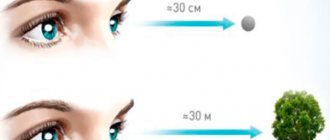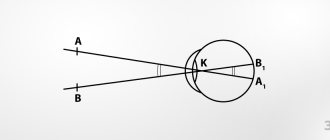After birth, the baby begins to adapt to the conditions of the surrounding world. At the same time, you need to understand that in newborns many organs function quite poorly, and vision is no exception to this rule. Medical research shows that most children's vision develops during the first four years of life, with the most active period of development occurring in the first 6 months of life. But how exactly does vision develop in a newborn? How does a baby's eye work? And what tips should parents remember when arranging a children's room? These issues will be discussed below.
Functions in the body
Vision in newborns develops over months from the moment the child is born, since there is no need for eyes in the womb.
An adult's vision is clear and performs a number of functions:
- light and color rendering;
- objective and central vision, which lays down the ability to recognize the shape and size of surrounding objects;
- peripheral and stereoscopic vision, forming the ability to perceive the space around a fixed point and the volume of the surrounding world.
At birth, a child does not have such opportunities. His visual image is blurry because the eye muscles are in an undeveloped state. Newborns often have mild squinting and unfocused gaze, which is completely normal.
At this time, the baby does not feel the need for a clear perception of the world. For the first 1-2 months, the child relies on hearing and tactile sensations from the mother’s body, to which he is accustomed.
Immediately after birth, vision in newborns performs the following functions:
- light perception, which allows you to determine whether it is day or night, gradually adapting the baby’s body to the daily routine;
- initial color perception in large objects;
- the ability to distinguish the basic outlines of the surrounding world, which is limited to the crib and the mother’s hands.
After birth, light becomes an impetus for the active development of the child’s visual functions. The clarity of vision increases and gradually the child develops the ability to fixate his gaze on objects. After 1.5 months. The newborn develops three-dimensional vision, which gradually helps him to distinguish colors and acquire central and object vision.
Color vision is present in children from birth, but is finally formed only by 4-5 years. The range of perception of objects and stereoscopic vision develops gradually as the baby’s motor skills and abilities develop.
Table of normal vision in children by age
Normal visual acuity is:
| Age | Visual acuity |
| 1 Week | 0.002 to 0.02 |
| 1 month | 0,02 – 0,03 |
| 3 months | 0,05 – 0,1 |
| 6 months | 0,1 – 0,3 |
| 1 year | From 0.3 to 0.6 |
| 2 years | From 0.4 to 0.7 |
| 3 years | 0,6 – 0,9 |
| 4 years | 0,7 – 1 |
| 5 years | 0,8 – 1 |
| 6 years or more | 0,9 — 1 |
Sensing Range and Range
At 1 month After the birth of a child, his pupils cannot focus on one object due to the weakness of the visual muscles and lack of coordination of their movements. The baby’s visual image is a bright space with bright spots without clear outlines, but already during this period the baby’s eyes actively react to light.
Starting from the 2nd week, the newborn tries to fix his gaze on objects whose outlines become clear. At this time, a three-dimensional picture is formed, but the baby cannot yet fully control his eyes, so sometimes the baby’s eyes run wide or squint.
However, these symptoms are temporary and pass quickly. True strabismus occurs in newborns in extremely rare cases and is expressed in other symptoms.
Changes in vision in newborns by month
The baby masters the perception of near space in a circle of 60 cm from himself by the end of 2 months, and premature babies by 2.5 months. During this period, the child is able to look at a round object for a long time.
In the future, the baby will learn to move his gaze from one object to another, which does not always work. At this time, the newborn is already able to distinguish between light and darkness, recognize mother and father, and examine large objects. At this moment, vision begins to help the child explore the world around him, which gives impetus to mental development.
During the period from 3 to 5 months. the newborn slowly begins to distinguish colors, including those located at a distance. First, children see different shades of yellow and red - the most saturated colors. And then calmer shades of blue and green up close and in the distance.
Changes in the degree of visual range of perception are largely associated with the development of motor skills. First, the baby distinguishes the colors of the toy and fixes his gaze on them. He then tries to pick up the rattle and take a closer look at it. Gradually, the child begins to distinguish geometric shapes and objects near him, after which his interest moves to longer distances.
For 5 months the baby is trying to see everything around. His gaze clings most to bright or interesting objects; in general, the range of gaze increases sharply to 2-3 m. The child gradually recognizes more distant objects and easily fixes his gaze even on moving objects.
He is most attracted to loud and active movements and bright colors. During this period, the formation of the far range of perception begins, which is fully formed by the end of 1 year.
| Type of perception | Age of formation, months. |
| Near range of perception | 1-4,5 |
| Far range of perception | 5-11 |
| Clearly captures moving objects at a distance | 11-12 |
Child development
Rating 59Useful facts for parents about the development of vision in a child at different age stages |
- Type
- Ask
- Send to a friend
- Share
- subscribe to news
Your baby has just been born. His little eyes that look around are the most beautiful thing you have ever seen. You don’t know what the child sees at this moment and whether his vision differs in any way from the vision of an adult. Since this question interests many young parents, we will try to understand it.
Although the baby's vision is not yet fully developed at birth, he can already distinguish colors. His vision develops gradually, stage by stage.
When do children develop vision?
By the end of the ninth month, the child's vision is as developed as that of an adult. It is finally formed by the end of the first year of life. During this period, the baby is strongly attracted to bright, contrasting colors.
A child’s eyes are ready to correctly perceive the world around him from birth, but his brain is not yet ready to process and interpret such complex information. Babies can distinguish colors at birth, but at a rudimentary level. Their ability to perceive different shades of color is limited.
Only after going through a number of stages of vision development will a child be able to see the world around him in all colors and shades. Let's take a closer look at these stages that last during the first year of a child's life.
Development of vision in a child
The following stages of vision development are distinguished:
- vision at birth;
- 0–2 months;
- 2–4 months;
- 4–8 months;
- 8–12 months.
Vision of a newborn baby: what parents need to know
1. Eye development. At day 22 of pregnancy, the eyes are two small grooves on the embryo. The optic nerve and subsequently the eyes are formed at this site.
2. Testing for congenital visual impairments. At the time of birth, the doctor checks for congenital visual impairments that could have arisen in the womb. Your doctor may give your newborn eye drops to help prevent eye infections.
3. How newborns see. At birth, a child can only see objects in black and white and shades of gray. This is due to the fact that the nerve cells of the brain and visual organs are not yet developed.
4. Inability to focus. A newborn baby cannot move his gaze from one object to another and focus on objects located at a distance of 15–20 cm from the face.
5. Farsightedness and myopia. Newborns may experience farsightedness or nearsightedness. Due to such vision defects, adults are forced to wear glasses. But in infants they do not cause concern. Vision defects can occur because children have an underdeveloped retina. Therefore, they decrease over time. You may also notice that your child reacts to bright lights by blinking or closing their eyes.
9 facts about vision development up to two months
1. What colors does a child see from birth? At birth, a child can see all colors, but it is not known which ones he sees more clearly than others. Research has shown that children can distinguish between primary colors (red, blue, green) from birth. Some children show a preference for one color. However, at this age, children cannot yet distinguish between similar colors (for example, red and orange). This means that the child recognizes colors, but does not distinguish between shades.
2. Lack of response. A child can look you straight in the eye, but his brain is not yet able to fully process the data received by his visual organs. So don't worry if you smile or wink at your baby and he doesn't react.
3. Dilated pupils. During the first two weeks, the baby's pupils are constricted to limit light entry. This is due to the fact that the retina of the eyes is still too sensitive. Only after the third week do the baby's pupils begin to dilate to allow more light into the eyes. After a few weeks, you will notice that your baby is keeping his eyes open for longer periods of time.
4. Blurred vision. In the first month of life, the child sees unclearly, as if in a fog. To attract the child's attention, objects should be large and bright.
5. Coordination of vision and hearing. By the end of the first month, the baby's hearing and vision are well coordinated. If you shake a rattle, for example, the baby will turn to face the source of the noise.
6. Development of peripheral vision. A child at this age has well-developed peripheral vision and can focus on objects located at a distance of one and a half meters from him.
7. The child learns to focus. The child's gaze may seem to wander. This is normal because he is still learning to focus on objects.
8. Clear perception of colors. By the end of the second month, the child learns to distinguish shades. However, he prefers brighter shades. This is why children's toys are usually so bright.
9. Mom smiles! The child can interpret the smile on the mother's face. At two months of age, he smiles back. This indicates that his vision has developed so much that he can now focus on certain objects.
Baby's vision at 2–4 months
1. The child perceives space better. At this age, the child develops the perception of depth and space. This means that he can estimate how far away the object he sees is from him. This happens because during this period the child has better developed coordination between the organs of vision and the brain.
2. The child watches the movement of objects. If you change the location of objects in the child’s field of vision, he will begin to look for them with his eyes. He also carefully observes any actions taking place near him. Shake the rattle in front of him and you will see how he will look at it without taking his eyes off.
3. The child distinguishes more colors. The number of colors and shades that he can perceive at this age increases significantly.
4. “I see you.” By the end of the fourth month, the child sees distant objects better. Now, if he sits near the window, he will see what is happening outside the window, rather than focusing his gaze on the glass surface.
Vision development at 4–8 months
1. Colorful world. At 5 months, the child already sees colors well.
2. The child distinguishes faces. The child better perceives the depth of space and recognizes familiar objects. He recognizes familiar faces and objects at a distance of several meters.
3. Permanence of objects. A child's vision becomes more and more similar to that of an adult. He notices small details and understands that objects are permanent and cannot disappear. Therefore, if you hide a toy in front of a child under a blanket, he will understand that it is somewhere nearby.
Vision development at 9–12 months
1. The child sees better. At this age, the child already sees almost the same as adults. His color perception is already fully developed, and his perception of space is significantly improved.
2. Eye color. At this age, the child’s eye color is almost formed and remains that way for the rest of his life.
3. The child can determine the distance to an object. He is able to distinguish between close and distant objects, their colors, and recognize familiar faces and objects.
4. Coordination of vision and muscle function. At the age of one year, the child develops coordination significantly, manifested in the coordinated action of the muscles and organs of vision. The child may look a little clumsy, but his coordination is still developing.
For proper development of vision in a child, it is necessary to undergo regular medical examinations. You should also pay attention to the manifestation of certain symptoms that may indicate vision problems.
Signs of vision problems
Parents need to be attentive to any deviations from normal vision development. Watch out for the following symptoms:
1. Red or swollen eyelids. This may be a sign of infection or allergy.
2. Excessive eye movements. The baby's visual muscles are still developing. Therefore, the child may make frequent eye movements. But if such movements are constant or excessive, it may indicate vision problems.
3. Severe sensitivity to light. If a child closes his eyes every time he goes outside in sunny weather, he may have increased intraocular pressure or problems with the retina.
4. Eyes constantly water. The baby's tear glands are still developing. Therefore, his eyes may often water or not produce tears at all.
5. White pupils. This can be a sign of various diseases, from cancer to cataracts. The appearance of such a sign requires immediate medical intervention.
When should a child have a medical examination?
Doctors recommend regularly showing your child to an ophthalmologist. This will help to recognize and treat a number of diseases in time.
1. Cataract. The lens of the eye in newborns is clear, just like in adults. But in some cases there may be cloudiness in it, which is called a cataract. The pediatrician usually notices cataracts during an examination immediately after birth or a few weeks later. Cataracts in newborns, as in adults, can be corrected surgically.
2. Blocked tear ducts. Sometimes babies can be born with blocked tear ducts. This may cause swelling and redness around the eyelids. Babies have weak immune systems, and an inflamed tear duct can become a breeding ground for bacteria. Treatment with antibiotics will help avoid the risk of vision loss.
3. Amblyopia, or “lazy eye syndrome.” A child may sometimes use only one eye for vision and therefore lose the ability to see with the other eye. The causes of amblyopia can vary, but often the disorder occurs due to a lack of coordination between the hemisphere of the brain and the opposite eye. Amblyopia is very difficult to detect at an early age because both eyes appear completely healthy. Regular eye exams can help diagnose this disorder.
4. Strabismus. In the first 4 months, it may seem to you that the baby's eye movements are not coordinated and each eye moves independently. Starting from the fifth month, the ocular muscles coordinate eye movements. If you observe uncoordinated eye movements in your baby even at six months, he may have developed strabismus. This disorder can be detected during an examination by an ophthalmologist. But, if you yourself notice such symptoms in your child, you should consult a doctor.
5. Retinopathy. This is retinal damage that occurs in children who are born prematurely. Retinopathy develops because the child's retinal blood vessels are not formed or formed incorrectly. Retinopathy is easy to detect during a physical examination.
6. Ptosis. This anomaly is that the movements of the child's eyelids are restrained by the muscles, and because of this, the eyelids remain motionless. Sometimes children are born with underdeveloped eyelid muscles, and because of this, the eyelid involuntarily appears drooping. This condition is called ptosis. Ptosis itself does not pose any threat to health, but can lead to the development of amblyopia. Fortunately, ptosis is easily treated with surgery.
How to help your child develop vision
To develop your child's vision at different stages of his life, follow these recommendations.
Up to 2 months
- Buy your child toys in bright and contrasting colors. Place them at a distance of 25 cm from the child;
- use dim lighting in the children's room. Bright lights can irritate him;
- During feeding, the baby usually looks at the mother's face. Therefore, hold the baby from different sides while feeding so that he can see you with both eyes;
- When your baby is one and a half months old, play this simple game with him. Keep him at a distance of 20 cm and look into his eyes. When he catches your eye, move him left and right. This exercise strengthens the child’s vision well;
- When the baby turns 2 months old, he begins to respond to your facial expressions. Smile at your child and talk to him. This will help develop his attention and visual memory.
2–4 months
- During this period, the child develops color perception. Surround him with bright objects, toys, etc.;
- When the baby is lying on his back, hang rattles over him. Let him look at them and touch them.
4–8 months
- let your child play with colorful cubes;
- bring him a basket with different fruits and let him look at natural colors;
- play hide and seek and other games with your child, during which he must find a certain object. For example, you can play a treasure hunt. This will force the baby to respond to visual stimuli;
- The child still loves brightly colored toys. Use this to get your child's attention.
9–12 months
- Play games with moving objects with your child. Throw a ball, use string toys, etc.
- Read colorful picture books to your child. Let your child point to the pictures and name what is drawn on them;
- Children of this age love to look at human faces. Therefore, allow your child to have as much contact with relatives as possible. This will teach him to remember new faces.
Rate the publication
Article rating: 4.54
out of 5 based on
13
ratings.
Related links:
- ▶ Eight simple tips for healthy vision
- ▶ Child development for 1 year month by month
- ▶ Child at 7 months: main indicators
- ▶ 1 year: main development indicators
- ▶ Important developmental indicators in the first year of life
- ▶ More articles on child development
Child development 12/04/2018
Item tracking
Vision in newborns develops individually over months. After birth, children are unable to follow objects due to underdeveloped visual muscles. Due to unfocused vision, the child is able to keep his gaze on a stationary object only by 1.5 months.
Gradually by 2 months. The ability to fixate the gaze on a moving object develops. Already at 8-10 weeks, an infant is able to follow the movement of objects at a distance of 60 cm.
Gradually, the child’s horizons increase. By 5-6 months. the child fixes his gaze on objects located at a distance of 2-3 m. Vision trains every day and becomes more clear.
From this period to 1 year, the child develops the ability not only to follow objects at a distance, but also to determine the range of objects. Even from a distance, the baby distinguishes between relatives and friends, tries to remember or recognize different types of objects (car, tree, house).
Gradually, the speed and ability of visual tracking improves and reaches a maximum. All children starting from 12 months. see the picture of the world more clearly and keep track of different objects better than many adults.
How a newborn sees - Learning to look
In the first weeks of life, a child rarely stops his gaze on anything for more than a few seconds. Even a couple of months after birth, when he has already learned to focus his gaze better, he does not hold it, but seems to glide over an object or face. Only by the age of 4 months will the baby learn to focus his gaze on an object. By the way, babies in a vertical position can focus their gaze on a face or an object longer, so if you want to play a little staring contest with him, take him in a vertical position.
Color perception
From birth, the child is able to see all colors, but distinguishes only the main ones.
These include:
- black;
- white;
- red;
- yellow;
- blue;
- green.
At first, the baby perceives only bright colors, often not distinguishing between similar shades (orange and red). He is attracted to rich shades of objects, which are easier to fix his gaze on. In the period of 2-4 months. the newborn begins to distinguish all primary colors, light and dark shades of the same color. The amount of color perception of the picture doubles, coloring the world brightly.
At 4-5 months. the child begins to see all colors. Thanks to the definition of halftones, he perceives space three-dimensionally and begins to understand the distance and proximity of individual objects.
The ability for active color perception of the world comes gradually and is completed only by 4-5 years. Color perception in newborns lays the foundation for the development of stereoscopic vision in an adult.
When a newborn begins to see - What do they like to look at?
The newborn's favorite object of study is... The human face! The face of his mother and father will be especially favorite for him. So give them this opportunity to look at your faces. There is something so... unusual and attractive about them. While playing “staring games” with your child, you may suddenly discover that the baby prefers to look at daddy’s face. Why? Simply because he has a more distinct outline, and even if he has a beard and mustache, this adds contrast to him. In priority after faces, black and white pictures (patterns or photographs) can become the favorite subject of looking at.
Newborns are very picky in their choice of items to consider. So, for example, if the mother always showed the baby wearing glasses, and then took them off, he may even turn away, as if digesting the changes that have occurred: “What happened to this picture?” This further confirms that newborns can store pictures and faces of loved ones in their memory.
Symptoms of deviation
Vision in newborns gradually normalizes month by month during the first year of development. When visual functions are developing, newborns often experience squint, unfocused and blurred eyes.
This is especially true for 1 and 2 months. development. All these signs are often temporary and disappear completely with the gradual development of coordination of the visual muscles.
However, after birth, parents should carefully monitor the child’s vision, since the baby himself does not see a difference in the surrounding picture, just as the pediatrician may not find changes during examination.
From birth to 5-6 months. Parents should carefully monitor the child in order to promptly notice signs of changes in the functioning of the eyes, which will indicate the presence of serious disorders.
These include:
- redness and large swelling on the upper eyelids;
- constant frequent eye movements that are repeated over a long period of time;
- increased sensitivity to light in a child, which provokes crying or anxiety in the baby;
- watery eyes for a long time or suppuration of the eyes (slight lacrimation in a child after birth and during the formation of visual functions may be present, but not for a long time);
- white pupils, when a whitish color is present in the very center of the child's eye at a certain angle.
All these signs, present over a long period of time (at least 2-3 days), will indicate the need to consult a specialist.
When does vision appear in newborns?
The formation of the visual analyzer begins as early as the 3rd week of intrauterine development and continues throughout pregnancy.
By the time of birth, the eye is anatomically formed, but some structures have not yet fully matured. The vision of a newborn child is caused by the following conditions:
- retinal immaturity;
- immaturity of neural connections between the optic nerve and the brain;
- immaturity of the visual centers of the cerebral cortex;
- weakness of the ciliary muscle;
- incomplete development of oculomotor nerves.
Given the immaturity of many structures responsible for vision, a newborn sees only light and shadow, that is, his vision is at the level of light perception. As the child grows and develops, the visual analyzer is formed, which leads to an improvement in visual functions.
Reasons for rejection
All deviations associated with changes in the development and functioning of the eyes in a newborn baby are provoked by serious diseases:
- Redness of the upper eyelids and puffiness of the eyes are most often accompanied by allergies, when the baby is intolerant to certain substances (lactose, wool particles and pollen in the air). In this case, the baby is given a blood test to confirm the allergic reaction and prescribe a course of antihistamines.
- When the child's tear ducts are blocked, the child no longer receives sufficient moisture to the eye. In a constant environment, a large number of bacteria are formed. Disruption of the tear ducts can cause vision loss if immediate action is not taken.
- Redness of the eyes and, in some cases, purulent discharge from the eyes accompany infections in the body (measles, chickenpox) or in the organs of vision (conjunctivitis). If the main cause of the disease is identified, the newborn is prescribed appropriate treatment, including mandatory antiviral drugs.
- Constant frequent uncontrolled eye movements often associated with the presence of a neurological disease in the child (Graefe syndrome). In this case, bilateral paralysis of the extraocular muscles indicates the need for immediate comprehensive treatment of the baby’s underdeveloped nervous system.
- An active reaction of a baby's eyes to light , especially in the morning, may be evidence of retinal damage or increased cranial pressure. In this case, the pediatrician prescribes an additional ultrasound and consultation with an ophthalmologist for the child to decide on the type of treatment.
- eyes constantly water not only due to improper functioning of the lacrimal glands, but also in case of damage to the cornea of the eye. In some cases, a bacterial infection can provoke lacrimation, which quickly resolves after starting a course of antibacterial agents.
- In rare cases, newborn babies may have a whitish pupil in one or both eyes. Such a violation indicates changes in visual functions due to cancer and cataracts.
Vision at 3 months
The baby can distinguish objects at a distance of up to 3 meters. Farsightedness continues to be developed, and nearby objects are less visible. The child recognizes his mother's face and follows moving objects well. Better perceives the volume and shape of objects, distinguishes blue, red, green, yellow colors.
Tips for parents
- It is useful to play peek-a-boo with your child. This develops spatial thinking, memory and three-dimensional vision well.
- You should offer the child a toy so that he can first see it, estimate the distance to it and reach it with his hand. This exercise can be performed by placing the child on his stomach, and the toy at arm's length from him.
- At three months, your baby usually enjoys transferring things from one hand to the other. To do this, you can give him a rubber ring or any large object of a simple shape.
When to see a doctor
In the first months of the child’s development, parents need to independently monitor the development of the baby’s visual functions. Minor deviations in vision and uncoordinated eye movements are often not permanent and do not require special treatment.
However, in some cases, parents need to immediately contact a pediatrician or ophthalmologist for consultation and treatment.
Such situations appear as:
- the presence of obvious clouding of the child’s pupil;
- lack of lacrimation and swelling of the eyelids;
- redness of the eyeballs and purulent discharge from them for 2 days. and more;
- lack of ability to see with both eyes. A baby using only one eye for vision is caused by amblyopia or lazy eye syndrome. Due to uncoordination of visual muscle movements between the hemispheres, the child may gradually lose the ability to see in one of the eyes. For these purposes, newborns are routinely checked for vision by an ophthalmologist after birth and by 1 year of age;
- strabismus after 4-5 months. after birth, it is a consequence of incoordination of eye movements in the brain and lays the foundations for true strabismus. When the disease is diagnosed at an early stage, there are methods of treating it;
- drooping eyelid in a child, which is detected when the muscles of the upper eyelid are underdeveloped. In this case, the child’s eyes cannot open much and seem to be half-closed. Ptosis is considered an abnormality and in some cases requires surgical intervention.
Any diagnosis of vision in a child is carried out by a pediatric ophthalmologist or pediatrician. In some cases, the baby is sent for additional examination to a pediatric neurologist if the disease is associated with underdevelopment of the nervous system.
Only a pediatric specialist can identify even minor changes and prescribe the necessary examination and treatment.
Vision at 1 month
The child can briefly hold his gaze on objects that are 25-40 cm away from him; follow moving large bright objects for a short time; distinguish contrasting colors. By the end of the 1st month (approximately 20-22 days), the movements of the baby’s eyeballs become clearer.
Tips for parents
Training the synchronous movement of the eye muscles can be done using the following exercises:
- bring a large bright toy at a distance of about 30 cm from the eyes of a child lying on his back, slowly move the toy up and down;
- hold the child in front of you, establish eye contact, slowly move relative to him left and right, then you can also slowly move the child in different directions relative to you;
- A good simulator for strengthening tracking skills is a mobile - a musical hanging toy with rotating objects, 30 cm is the optimal distance for installing it.
Possible complications
Vision in newborns, the months of development of which can be traced to correspondence to the norm of formation, in the early stages of development is easily treatable and returns to normal.
Minor deviations in visual function in newborns are most often temporary and associated with the process of formation of visual muscles and coordination. However, if there are any peculiarities, you should contact your treating pediatrician for advice.
If persistent symptoms of deviation of visual functions from the norm are detected, parents must urgently begin treatment for the child.
Otherwise, the baby may:
- visual acuity decreases greatly, even to the point of blindness;
- bacterial infections of adjacent tissues develop;
- changes in the development of the eyeball may occur, which will require its removal;
- swelling of the larynx, choking or prolonged diarrhea begins in the absence of proper treatment of allergic manifestations;
- develop a chronic neurological disease.
Vision in newborns develops gradually and with timely detection of abnormalities and diagnosis of the disease, the baby has the maximum chance of complete recovery. Based on the months of norms for the development of vision functions, it is easy to verify the compliance of the newborn’s development with general requirements.
Parents' complaints about their child's vision, together with an examination by a pediatrician and pediatric ophthalmologist, will help provide the child with timely medical care with a competent course of medications to restore his health and enable him to see well and clearly.
How a newborn sees - Unfocused gaze
Sometimes parents notice that their child’s eyes sometimes squint. Not constant (periodic) squinting of the eyes during the newborn age is normal. But if your eyes constantly squint, it’s better to consult a doctor. Until about 6 months, babies may squint their eyes at times. Newborns do not look with both eyes at the same time and the visual image does not appear in the same place on the retina.
This is the result of a still insufficient depth of perception. As you grow, your gaze will become more focused. The process of binocular vision develops from 6 weeks of age to 4 months.











